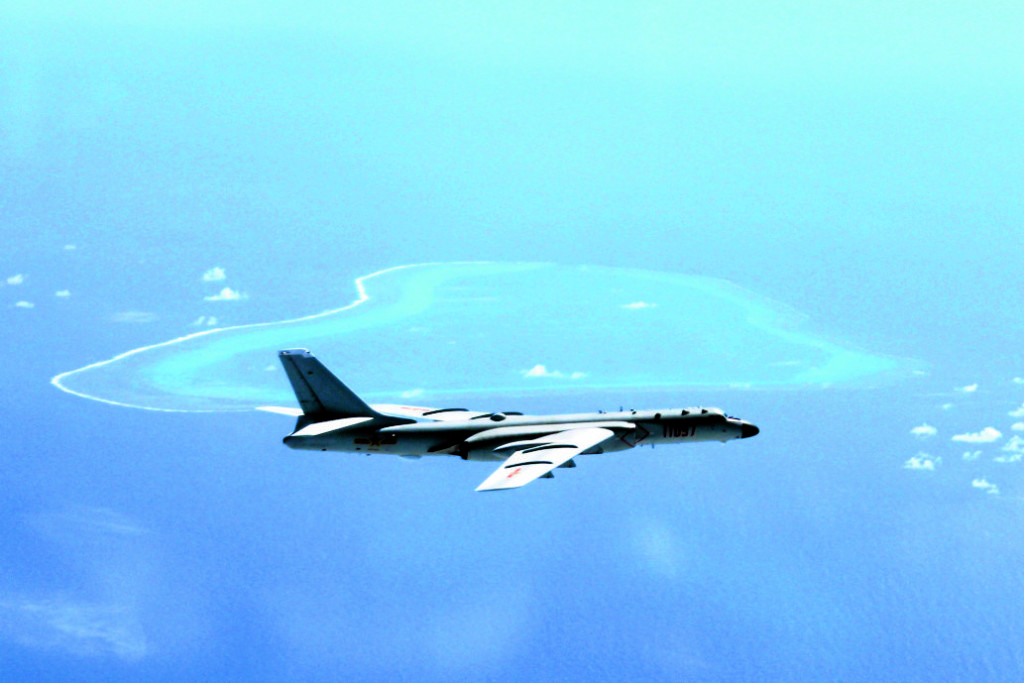
AIR SECURITY A Chinese bomber patrols the islands and reefs in the South China Sea in this undated photo released by Xinhua News Agency. —AP FILE PHOTO
China’s presence in the Philippines has never been more pronounced than it is now.
Manila recently allowed a Chinese ship to conduct maritime research at a resource-rich vast underwater plateau known as Benham Rise, east of the main island of Luzon, near US bases in Guam and Hawaii.
For months, the Philippines has been drumming up a joint venture with China to explore for oil and gas in a contested area of the South China Sea.
China is also dipping its fingers into the Philippine telecoms industry. Shenzhen-based telco ZTE is leading a consortium that plans to invest US$2 billion (S$2.6 billion) to build 50,000 microcell towers and compete with the two leading players.
Most big-ticket infrastructure projects have some level of Chinese involvement.
Tourists from China are also pouring in. The Chinese have dislodged the Koreans as the top tourists on the resort island of Boracay. Some 376,000 tourists from the mainland visited Boracay last year, compared with 375,000 from South Korea.
A historic ruling by an international tribunal in The Hague granting the Philippines rights to vast waters China is claiming, meanwhile, is fast slipping out of the national consciousness.
All this, of course, plays to President Rodrigo Duterte’s brand of diplomacy. Since he took office in 2016, ties between Manila and Beijing have never been as warm or mutually beneficial.
China has pledged over US$24 billion in investment and loans to help finance Mr Duterte’s ambitious 3 trillion peso (S$77 billion, US$59 billion) “Build, Build, Build” infrastructure plan.
Beijing has also backed, with funding and weapons, Mr Duterte’s brutal crackdown on the narcotics trade and war against Islamist terrorists.
In turn, Mr Duterte has set aside the decision from The Hague. He has also looked the other way as China fortifies its island bases in the South China Sea.
When told China had transformed Fiery Cross reef into a 2.8 sq km airbase, Mr Duterte’s spokesman Harry Roque said “there is still no breach of good faith, as long as China has not embarked on new reclamations”.
Mr Duterte is indeed rolling out the red carpet for China.
That pivot, however, has not come without consequences, especially as it relates to the Philippines’ decades-long relationship with the United States.
US Defence Secretary Jim Mattis has turned to Indonesia and Vietnam, instead of the Philippines, to lead a pushback against China’s expansion in the South China Sea.
Mr Duterte’s aides have been obfuscating his pro-China remarks to allay concerns in Washington.
Seeking to downplay the Chinese presence at Benham Rise, Foreign Secretary Alan Cayetano said the Philippines, since 2000, has approved all 13 requests from the US to conduct maritime research there, all nine Japanese requests, and all four from South Korea.
China filed 18 requests, but only two were approved, he said.
“I’ll let the numbers speak for themselves,” he told reporters. “Tell me, who are we favouring?”
Defence Secretary Delfin Lorenzana, meanwhile, said Manila would lodge a diplomatic protest over the militarisation of Fiery Cross reef.
“If it is true, and we can prove that they have been putting soldiers, and even weapons systems, that will be a violation of what they said,” he said.
Dr Amado Mallonga, an expert on geopolitics at the University of the Philippines, said the Chinese are just “behaving like they should behave”. “China is a state, and it has state-owned enterprises,” he added. “Obviously, the activities of its enterprise will be aligned with its foreign policy, and they see an opening because Duterte is open to them.”